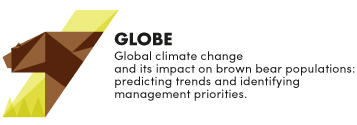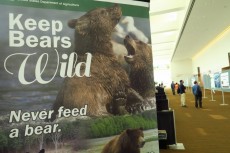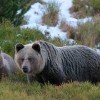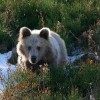
We recommend our new article “Brown bear attacks on humans: a worldwide perspective” www.nature.com/articles/s41598-019-44341-w
 A new study coauthored by European experts and led by Carlos Bautista shows that every year European countries pay farmers almost EUR 30 million to compensate for large carnivore damages like wolves killing sheep or bears attacking beehives. Wealthier countries pay the majority of compensations; most of them are due to predation of free-ranging unprotected livestock, which represents 68% of the total costs. Norway pays the most, over EUR 12 million a year to compensate attacks on free-ranging reindeer and sheep. Most countries compensate damages every year but only half of them subsidize preventive measures regularly, the rest virtually omit it. The bulk of all money spent in prevention programs in Europe goes to restructure husbandry practices in countries where reintroduced and recovering populations of predators is growing in areas with free-ranging unprotected livestock. That is the case of France, where prevention costs can reach EUR 10 million per year, including paying shepherd salaries and providing livestock guarding dogs, among other measures. Yet, such big investments sometimes fail to prevent damage and hardly change the farmer’s antipathy towards these predators.
A new study coauthored by European experts and led by Carlos Bautista shows that every year European countries pay farmers almost EUR 30 million to compensate for large carnivore damages like wolves killing sheep or bears attacking beehives. Wealthier countries pay the majority of compensations; most of them are due to predation of free-ranging unprotected livestock, which represents 68% of the total costs. Norway pays the most, over EUR 12 million a year to compensate attacks on free-ranging reindeer and sheep. Most countries compensate damages every year but only half of them subsidize preventive measures regularly, the rest virtually omit it. The bulk of all money spent in prevention programs in Europe goes to restructure husbandry practices in countries where reintroduced and recovering populations of predators is growing in areas with free-ranging unprotected livestock. That is the case of France, where prevention costs can reach EUR 10 million per year, including paying shepherd salaries and providing livestock guarding dogs, among other measures. Yet, such big investments sometimes fail to prevent damage and hardly change the farmer’s antipathy towards these predators.
Please enjoy the new article https://www.sciencedirect.com/science/article/pii/S0006320718314423?dgcid=coauthor
 Humans have never provided so much food to wildlife. Wildlife feeding is widespread, but not necessarily good for wild animals and ecosystems. A new study warns that deer feeding may have unintended consequences. It affects not just deer but also changes the movement behavior of brown bears that now routinely visit feeding sites for deer. Researchers call for an urgent reevaluation of wildlife feeding practices.
Humans have never provided so much food to wildlife. Wildlife feeding is widespread, but not necessarily good for wild animals and ecosystems. A new study warns that deer feeding may have unintended consequences. It affects not just deer but also changes the movement behavior of brown bears that now routinely visit feeding sites for deer. Researchers call for an urgent reevaluation of wildlife feeding practices.

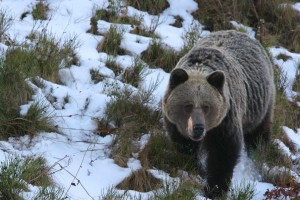 Warming climate drove the decline of brown bear twofold, indirectly by promoting human expansion, but also directly, possibly by disturbing bears' hibernation period, new study published by the GLOBE team in the Scientific Reports shows.
Warming climate drove the decline of brown bear twofold, indirectly by promoting human expansion, but also directly, possibly by disturbing bears' hibernation period, new study published by the GLOBE team in the Scientific Reports shows.
12,000 years ago brown bears used to roam over the entire European continent, but gradually their species' range collapsed to today's patchy populations. This decline coincided with rapid expansion of humans, but also with climate warming. Brown bears live in a wide range of climates, from dry deserts to cold Arctic tundra. Why would increase in temperature exert an adverse effect on them? It is the bears' winter hibernation, when female brown bears give birth, that turns out to be the most vulnerable period. Counter-intuitively, bear females need more energy during hibernation when it is warmer, which means they need to feed longer to build up more fat. By comparing data on female reproduction from bear populations around the world, the researchers found that indeed bears reproduce at lower rate at higher temperatures.
 A new study realised (among others) by the GLOBE project team members, finds that bears communicate through their feet while walking. By twisting their feet into the ground, bears leave their scent. This scent is produced by foot glands and contains 26 specific compounds that inform other bears, for example about the sex of the animal. This ritual is repeated by other individuals, mostly males, which step exactly in the same places, leaving a trail of smelly holes in the ground. This reveals as an important way for animals with large home ranges to exchange information with their neighbours.
A new study realised (among others) by the GLOBE project team members, finds that bears communicate through their feet while walking. By twisting their feet into the ground, bears leave their scent. This scent is produced by foot glands and contains 26 specific compounds that inform other bears, for example about the sex of the animal. This ritual is repeated by other individuals, mostly males, which step exactly in the same places, leaving a trail of smelly holes in the ground. This reveals as an important way for animals with large home ranges to exchange information with their neighbours.
 The last interim meeting of the GLOBE project team took place again in Zakopane (Poland) on 5-9 December 2016. As last year, we again had the opportunity to meet in the hospitable Center for Research and Conservation of Mountain Plants of the Institute of Nature Conservation PAS, where for few days GLOBE team researchers and collaborators had opportunity to meet and discuss. We worked on the results achived by the time on the issues related to the stress, diet analyses based on stable isotopes, as well as modelling of climate and human-bear relations. Though the weather was a bit harsh, we had a chance to spend some time outside too. The meeting in Zakopane was attended by both researchers responsible for implementing specific research tasks and all the young researchers recruited for a post-doc in the GLOBE project. Although this is our last meeting in the framework of the project GLOBE, we hope it was not the last in such inspiring and creative team.
The last interim meeting of the GLOBE project team took place again in Zakopane (Poland) on 5-9 December 2016. As last year, we again had the opportunity to meet in the hospitable Center for Research and Conservation of Mountain Plants of the Institute of Nature Conservation PAS, where for few days GLOBE team researchers and collaborators had opportunity to meet and discuss. We worked on the results achived by the time on the issues related to the stress, diet analyses based on stable isotopes, as well as modelling of climate and human-bear relations. Though the weather was a bit harsh, we had a chance to spend some time outside too. The meeting in Zakopane was attended by both researchers responsible for implementing specific research tasks and all the young researchers recruited for a post-doc in the GLOBE project. Although this is our last meeting in the framework of the project GLOBE, we hope it was not the last in such inspiring and creative team.

Photos: GLOBE team in front of the Center for Research and Conservation of Mountain Plants of the Institute of Nature Conservation PAS and on the top of the Kasprowy Wierch.

An interesting interview with Nuria Selva, leader of the GLOBE project, was published in one of the most influential Polish weeklies, “Tygodnik Powszechny”. Nuria talks about her research, about Puszcza Białowieska, about bears and about her perception of life. Truly interesting read (unfortunately only in Polish)!
 Members of the GLOBE project participated at the "24th International Conference on Bear Research and Management" organized by the International Association for Bear Research & Management (http://www.bearbiology.com/) in Anchorage, Alaska, on 12-16 June 2016. Bear physiology and human-bear coexistence were among the main focus of the conference. Researchers of the GLOBE team had the opportunity to present results of the research conducted within the project, gave 5 oral presentations and presented 4 posters, they took part in numerous inspiring discussions during and after the conference, and what is equally important, had the opportunity for extraordinary meetings with Alaskan bears (and not only!).
Members of the GLOBE project participated at the "24th International Conference on Bear Research and Management" organized by the International Association for Bear Research & Management (http://www.bearbiology.com/) in Anchorage, Alaska, on 12-16 June 2016. Bear physiology and human-bear coexistence were among the main focus of the conference. Researchers of the GLOBE team had the opportunity to present results of the research conducted within the project, gave 5 oral presentations and presented 4 posters, they took part in numerous inspiring discussions during and after the conference, and what is equally important, had the opportunity for extraordinary meetings with Alaskan bears (and not only!).
